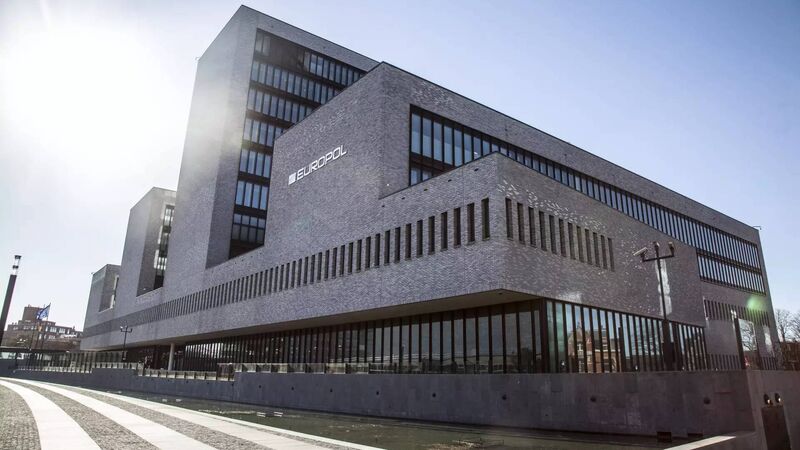Irish gangs among the major crime groups posing a security threat to Europe

The EU police agency, Europol, said these gangs represent the “most threatening criminal networks” in Europe. Picture: Europol
Irish gangs are among more than 820 major crime groups posing a security threat to Europe, according to the first ever such dossier of organised crime in the EU.
The EU police agency, Europol, said these gangs represent the “most threatening criminal networks” in Europe.
The 821 networks involve around 25,000 individuals, from 112 different nationalities. The examination of the EU’s top gangs is based on national figures provided by the 27 member states, including Ireland.
It is the first such police “map” of the dangerous criminal outfits in the EU and provides details on the illegal activities they are involved in, how and where they operate and what makes them pose a heightened threat.
The report, , does not provide a breakdown of gang numbers by member state.
But the understands that separate official figures suggest that there are at least 15 drug gangs operating at a national level in Ireland, while there are also criminal networks operating in other areas of organised crime, including fraud, money-laundering as well as human- and sex-trafficking.
The bulk of the 15 Irish drug gangs have international connections and many, such as the Kinahan crime cartel, have direct links with cartels in Colombia and Mexico.
The Garda National Crime and Security Intelligence Service (GNCSIS) provided the figures for Ireland based on analysis by its National Criminal Intelligence Unit using criteria supplied by Europol.
Last month, Europol and the EU drugs agency, EMCDDA, said there was “increasing use” of EU countries as a “transit point” for the global shipment of cocaine, with evidence of greater collaboration between Latin American and European criminal networks.
In a statement on the report, Europol said serious organised crime continues to represent “a major threat to the internal security” of the EU.
It said that to effectively prioritise resources and guide policy action, law enforcement and policymakers need to build a clear understanding of the most threatening criminal networks active in and affecting the EU.
Europol’s new report identifies the characteristics of the criminal networks that pose the highest threat. “This Europe-wide analysis from the perspective of the criminal actors is a first,” Europol said.
“It describes in depth how the most threatening criminal networks are organised, what criminal activities they engage in, how and where they operate as well as which of their characteristics heighten their threat.”
It said the work stemmed from priorities set by the Belgian presidency of the Council of the EU.
Speaking at Friday's launch, Europol executive director Catherine De Bolle said: “Criminals thrive in secrecy, but we are changing that. This Europol report is the most extensive study on key criminal networks ever undertaken at the European level by law enforcement.
“Thanks to the collaboration of all EU Member States and 17 Europol partner countries, we are shining a light on the activities of the most threatening criminal networks in the EU.
Belgian justice minister Paul Van Tigchelt said combating organised crime "is an absolute priority for the Belgian presidency" adding that the report "is an important new weapon in that fight". The country's home affairs minister Annelies Verlinden said the report reflected “a new era” in policing and that agencies were “turning the tide” on organised crime.
European Commissioner for Home Affairs, Ylva Johansson, said that organised crime "is one of the biggest threats we face today". She said a third of the more than 800 networks have been active for more than 10 years. She said gangs use end-to-end technology, adding: "We need end-to-end police co-operation to fight them."
European Commissioner for Justice Didier Reynders added: “The impact of these findings will have significant implications for justice systems across the EU and the rule of law. Judges and prosecutors can only fight organised crime if they are free from intimidation, threats or attempts to influence their professional integrity. We must assure that this is the case.
"As the most threatening criminal networks run borderless criminal operations, co-operation between experts is vital. This is why the commission will be supporting proposals for a new EU judicial network, to be placed at Eurojust, with a focus on organised crime, including high-value targets.”
The analysis is based on a unique dataset which was contributed to Europol specifically for this purpose, and complemented with additional information already shared with Europol as the European hub for criminal information.
All EU Member States and 17 of Europol’s partner countries contributed data to identify the most threatening criminal networks in Europe. This resulted in a unique dataset of 821 of the most threatening criminal networks, with extensive information on all aspects that describe them and help assess their threat.
These criminal networks, whose membership exceeds 25,000 individuals, were selected based on criteria around the threat they pose. “These networks are active in a range of crime areas, from drug-trafficking to migrant smuggling, property crime and others,” Europol said.
Through a comprehensive analysis of 821 criminal networks, an “ABCD framework” was developed, shedding light on their fundamental characteristics.
By categorising key aspects of these groups into four distinct dimensions — A for Agile B for Borderless, C for Controlling, and D for Destructive — the ABCD framework offers valuable insights into their modus operandi, structures, and operational patterns.
The most threatening networks are:
- They exhibit agility to adapt their criminal business processes to opportunities and challenges, including those posed by law enforcement. They are able to extensively infiltrate and misuse legal business structures. This helps their criminal businesses thrive, allows them to launder their criminal profits and shield them from detection. 86% of the most threatening criminal networks make use of legal business structures, the vast majority in the EU.
- The most threatening criminal networks run borderless criminal operations. Their activities touch upon many countries in the world, and their composition is very international, with network members from many countries in the EU and the world. A total of 112 nationalities were represented among the members of the 821 most threatening criminal networks, with 68% of the networks composed of members from multiple nationalities. But, looking at the place of their core activities, the vast majority maintain a strong geographical focus and do not extend their core activities too broadly.
- The most threatening criminal networks exert strong control and focus over their criminal operations. They tend to specialise in one main criminal business; truly polycriminal networks are the exception rather than the norm. The leadership of 82% of the most threatening criminal networks is settled either in the main country of activity, or the country of origin of the key members.
- The criminal activities and corruptive practices of the most threatening criminal networks are inflicting significant damage to the EU’s internal security, rule of law and economy. Half of the most threatening criminal networks are involved in drug-trafficking as the/a main criminal activity. More than 70% of networks engage in corruption to facilitate criminal activity or obstruct law enforcement or judicial proceedings. 68% of networks use violence and intimidation as an inherent feature of their modus operandi.
Europol said this analysis will be further elaborated in forthcoming Europol reports, such as the EU Serious and Organised Crime Threat Assessment 2025.
The agency said the data, now centralised at Europol, will assist national law enforcement authorities to better target and conduct their cross-border criminal investigations.













